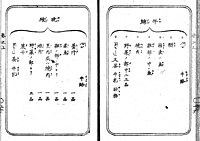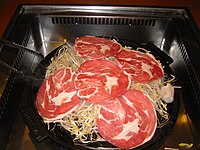This is an old revision of this page, as edited by Masonfamily (talk | contribs) at 18:10, 31 October 2008 (your reason is not criteria of whole revert. Undid revision 248857949 by Sennen goroshi (talk)). The present address (URL) is a permanent link to this revision, which may differ significantly from the current revision.
Revision as of 18:10, 31 October 2008 by Masonfamily (talk | contribs) (your reason is not criteria of whole revert. Undid revision 248857949 by Sennen goroshi (talk))(diff) ← Previous revision | Latest revision (diff) | Newer revision → (diff)
Yakiniku (焼き肉 or 焼肉), meaning "grilled meat", is a Japanese term which, in its broadest sense, refers to grilled meat dishes.
Today, it commonly refers to a Japanese style of cooking bite-sized meat (usually beef and offal) and vegetables on gridirons or griddles over flame of wood charcoals carbonized by dry distillation (sumibi, 炭火) or gas/electric grill. In North America, China and Taiwan, Yakiniku is also referred to as either "Japanese barbecue" or "Korean barbecue" due to its Korean origins.
It is thought to have originated from horumonyaki, a dish of grilled offal, invented by Korean immigrants in the Kansai area after the Second World War.
In a yakiniku restaurant, diners order several types of prepared raw ingredients (either individually or as a set) which are brought to the table. The ingredients are cooked by the diners on a grill built into the table throughout the duration of the meal, several pieces at a time. The ingredients are then dipped in sauces known as tare before being eaten. The most common sauce is made of Japanese soy sauce mixed with sake, mirin, sugar, garlic and sesame. Garlic-and-shallot or miso-based dips are sometimes used, and sometimes yakiniku is eaten seasoned only with salt. Soup, kimchi, nameul, bibimbap and other Korean-influenced dishes are often served alongside.
History


Etymology
Before Meiji Era, Japanese did not eat a meat. and did not have a Meat-eating culture. it was officially legalised in 1871 following Meiji Restoration. as part of an effort to introduce western culture to the country The Emperor Meiji himself was brought in to be publicly observed eating beef on January 24, 1873 to promote beef consumption. Steak and roasted meat were translated as yakiniku (焼肉) and iriniku (焙肉), respectively, as proposed western-style menus in Seiyō Ryōri Shinan published in 1872, although this usage of the former word was eventually replaced by the loanword sutēki.
Jingisukan (ja:ジンギスカン, Japanese transliteration of Genghis Khan), is a style of grilling mutton, which is also referred to as a type of yakiniku. It was first conceived 1931 in Hokkaidō, where it has ever since been a popular blue-collar dish, but has only recently gained nationwide popularity.
Origin
Common Japanese style of Yakiniku, drawing influences from Korean dishes such as bulgogi and galbi, became widespread in Japan during the 20th century, most notably after the Second World War. Restaurants serving this dish either advertised themselves as horumonyaki (ja:ホルモン焼き, offal-grill) or simply Joseon (Korean) cuisine (朝鮮料理, chōsen ryori). The division of the Korean peninsula led to disagreements in the mid-1960s in the naming of "Korean food", with pro-South businesses changing their signs to "kankoku ryori (韓国料理)" (named after Republic of Korea) rather than sticking to the term chōsen (Joseon), the name of the old, undivided Korea.
Ventilated barbecue systems, introduced by Shinpo Co., Ltd. in March 1980, quickly spread throughout Japan as it enabled diners to eat Yakiniku in a smoke-free environment and thus greatly extended the clientele.
The Seoul Olympics in 1988 led to a surge of interest in Korea, and yakiniku became more popular in Japan. The popularity of yakiniku was given a further boost in 1991 when the easing of beef import restrictions led to a drop in the price of beef. However the industry was dealt an unprecedented blow in 2001 with the occurrence of BSE (mad cow disease) within Japan.
Many yakiniku restaurants in Japan have been run by ethnic Koreans including the president of All Japan Yakiniku Association and thus yakiniku industry is sometimes regarded as an "ethnic industry".
Similarity to and difference from Korean barbecue


Japanese yakiniku usually differs from authentic Korean dishes such as galbi and bulgogi in several aspects.
The word karubi, Japanese pronunciation of galbi), when used in Japan, solely refers to beef short rib, and is not used to refer to similar meat in other animals as they are in Korea, such as Dwaeji galbi (돼지갈비 pork galbi) or Dakk galbi (닭갈비 chicken galbi).
Cutting grilled meat with scissors, as done in Korea, is not standard practice in yakiniku restaurants and customers grill meat by themselves in yakiniku restaurants.
The most popular style of yakiniku in Japanese cuisine corresponds to Korean sen galbi gui (생(鮮)갈비구이) or samgyeopsal, and marinated yangnyeom galbi (양념(藥念)갈비) is generally considered as more Korean.
Typical Ingredients
Typical ingredients include:
- Beef and pork
- Rōsu - loin and chuck slices
- Karubi or baraniku - short ribs. From the Korean word "galbi". In Japan it is usually served without the bones, unless it is specified as hone-tsuki-karubi (galbi on the bone).
- Horumon or motsu - Offal.
- Harami - tender meat around the diaphragm.
- Rebā - beef liver. From the German word "de:Leber".
- Tan - beef tongue. From the English word "tongue". Often served with salt and lemon juice..
- Tetchan - intestine. From the Chinese word "大肠" (da chang). May simply be referred to as horumon.
- Hatsu - heart. From the English word "heart".
- Mino / Hachinosu - beef tripe
- Chicken
- Seafood - squid, shellfish
- Vegetables - bell pepper, carrots, shiitake and other mushrooms, onions, cabbage, eggplant, bean sprout, garlic, and kabocha squash are common
Yakiniku is usually served with rice or beer. Korean soups, kimchi, bibimbap, namul, lettuce and other sometimes Korean-influenced salads are other common side dishes as well as raw meat dishes such as yukhoe, sashimi of meat, liver, and omasum.
Yakiniku Day
In 1993, the All Japan Yakiniku Association proclaimed 29 August as official "Yakiniku Day" (yakiniku no hi).
See also
- Yakitori
- Teriyaki
- Teppanyaki
- Yakisoba
- Galbi
- Bulgogi
- Gyu-Kaku, a chain of yakiniku restaurants
- Cuisine of Japan
- Korean barbecue
References
- Noelle Chun Yakiniku lets you cook and choose, The Honolulu Advertiser, August 20, 2004.
- Chantal Garcia Japanese BBQ a best kept L.A. secret, Daily Trojan, 11/10/04.
- Lie, John (2001). Multiethnic Japan. Harvard University Press. p. 77. ISBN 0674013581.
- On the revolution in Japanese meat-eating habits during the Meiji period, see Shibusawa, comp., Japanese Life and Culture in the Meiji Era, 65–69. For more on Japanese food culture in general, see Michael Ashkenazi and Jeanne Jacob, The Essence of Japanese Cuisine: An Essay on Food and Culture (Philadelphia: University of Pennsylvania Press, 2000).
- Template:Ja icon 日本における肉食の歴史, 歴史と世間のウラのウラ.
- Template:Ja icon 館内展示パネル-洋食 欧米食と和食の融合, Kikkoman Institute for International Food Culture.
- Donald Ritche THE ASIAN BOOKSHELF - What made Japan join the fast-food nations?, The Japan Times, March 11, 2007.
- Kanagaki Robun - Agura Nabe in 1871-2 (仮名垣魯文著『安愚楽鍋』) ASIN B000JA7KJU
- Template:Ja icon 敬学堂主人 (Keigakudō shujin) 西洋料理指南 (Seiyō Ryōri Shinan), 1872, P28.
- Template:Ja icon 「探偵団がたどる ジンギスカン物語」 調査報告その3 ルーツを探る, Hokkaido Shimbun, 2003/01/09.
- "Ghengis Khan gets hip", The Japan Times, Feb. 3, 2006.
- Template:Ja icon 会社概要-沿革 Shimpo Co., Ltd. "1980年3月 無煙ロースター(モスマック)の販売を開始。(introduced a smokeless roaster (Mosumakku) in March, 1980)." OGASAWARA SEIJI (小笠原静司)/SHINPO KK, ロースターの排気システム 特公昭57-052050 (EXHAUST SYSTEM OF ROASTER, JPB57075620 (1982)). YAMADA TAKESHI (山田武司)/SHINPO KK, ロースターの消煙装置 特開昭61-234822 (SMOKE DISTINCTING APPARATUS OF ROASTER, JPA61234822 (1986)).
- Jamie Miyazaki, Japan's showbiz fans look to S Korea, BBC News, 13 December, 2004. "This is not the first time, though, that Japan has taken a cultural interest in its smaller and often overlooked neighbour. A similar wave of interest swept the country during the 1988 Seoul Olympics."
- Kazuhiro Soga (曽我 和弘, Soga Kazuhiro),Kansai food business society, http://shokubi.hp.infoseek.co.jp/soga.htm 炭火焼きブームは何故起こったのか], "この炭火焼ブームは焼肉ブームに端を発している。規制緩和の問題により、肉が輸入自由化となり、米・豪から安い輸入肉が入るようになった。このことにより激安焼肉店が生まれてくるわけだが、店としては「肉が旨い」というフレーズを使いたい。かといってその代名詞である「和牛オンリー」とは言いづらい、そのため「旨い」という印象を与える「炭火」という言葉を使ってそのイメージアップをはかっているのである。"
- Template:Ja icon 北朝鮮問題がもたらす在日商工人の危機 焼肉・韓国食品業界, onekoreanews.net, 2007-1-1.
- Template:Ja icon 米国産牛 輸入再開に強い期待 全国焼肉協会が総会, onekoreanews.net, 2007-5-30. "冒頭挨拶で朴泰道会長は、牛肉の輸入再開問題について言及した。"
- Template:Ja icon サバイバル焼肉戦争の現場(上)/売上業界1位安楽亭, Choson Sinbo, 19991004. "在日同胞が生み、育て、民族産業とも言われる焼肉業界。"
- Template:Ko icon 일 고기구이 체인점 '규카쿠'… 특수 석쇠로 옷에 고기냄새 안배게 해, Chosun Ilbo, 2008.02.04.
External links
- Yakiniku Web, the official site of the All Japan Yakiniku Association (in Japanese)